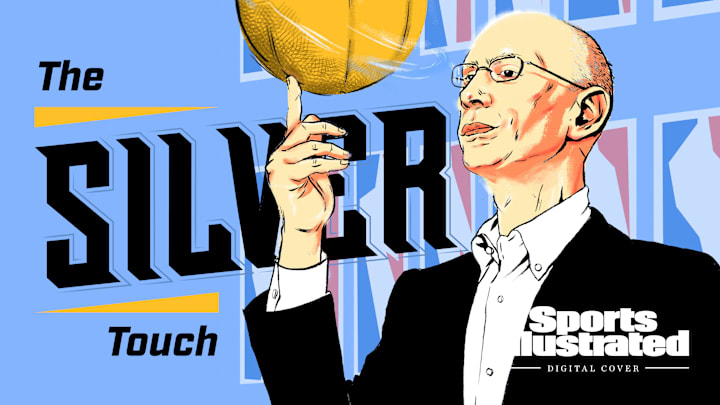Tracking Adam Silver’s Agenda for Next Term as NBA Commissioner

Adam Silver, who last January agreed to a contract extension that will keep him in the NBA commissioner’s office through the end of the decade, begins his next term with … nothing to do. “There’s a lot to do,” insists Silver, chuckling. True, running a multibillion-dollar sports league with its tentacles everywhere around the globe is a full-time job. But Silver begins his 11th year as commissioner with the biggest agenda items already taken care of. Last year the league and the players union ratified a new seven-year collective bargaining agreement. In July, the NBA finalized a new broadcast rights deal, an 11-year, $77 billion windfall that will kick in next season. For the time being, it looks like clear sailing ahead.
Silver will happily acknowledge that, structurally, the NBA is in as good a place as it has been in ages. “Not just in my time as commissioner,” Silver says. “But in my [32] years at the league.” Parity, a decades-long dream of the NBA, has been achieved. Over the last six seasons, the league has crowned six different champions, with not so much as a back-to-back finalist. The CBA has choked off the ability of large-market teams to spend their way to success. “It goes more to how the team is built rather than to the outcome,” Silver says. “We want teams to be rewarded for drafting well and developing players well.”
So what are Silver’s priorities now? In a wide-ranging interview, he addresses the key items that remain on his agenda.
Item 1: NBA Expansion
With the CBA and the broadcast deals wrapped up, the possibility of the league adding teams for the first time in 20 years moves to the front burner. While it’s believed that the NBA will add two cities—with Seattle and Las Vegas as the front-runners—Silver cautions that any expansion talks are preliminary. While admitting two new teams could generate up to $10 billion in franchise fees, there are also concerns.
Silver’s take: “It’s one of the reasons why expansion isn’t as obvious as some people might think. There is a point of view that I often encounter that expansion is printing money. It’s not. First of all, you’re in essence selling equity in the league. To the extent you have new national television deals, you now have two new partners, so you’re dividing up the money by two additional ways. There’s also a dilution of talent. It’s one of the reasons we haven’t expanded anytime recently, because we’ve been working towards creating a more competitive league.”
Item 2: WNBA Expansion
The women’s game, Silver says, could expand more quickly. The league recently added a franchise in San Francisco to begin play next season, with Portland and Toronto joining in 2026, bringing the total to 15 teams. Interest in the WNBA, fueled in large part by the arrival of Caitlin Clark and Angel Reese, has exploded.
Silver’s take: “I know both [WNBA] commissioner [Cathy] Engelbert’s and my phones have been ringing off the hook over the last several months from parties interested in owning or investing in WNBA teams. When we launched the league 28 years ago, our goal was to have a WNBA team affiliated with every NBA franchise. We’ve clearly had some fits and starts along the way, and it may be that there are markets that the NBA is not in which make a lot of sense for the WNBA. At the same time, our goal would be to have a robust league roughly equivalent to the NBA. The fact that there’s all this interest doesn’t mean we should expand that quickly. We should be careful and deliberate in the way we do it.”
Item 3: Enhancing the Fan Experience
This, Silver says, “is at the top of my agenda.” The NBA is satisfied with its in-game experience. Arenas were at 98% capacity last season, and teams continue to innovate in areas such as food, accessibility and entertainment. “There’s not a lot of room to grow there,” Silver says. Where there is room is in the home viewing experience.
Silver’s take: “There’s enormous opportunity to grow, especially on a global basis. What that will require is using new technology that’s largely coming through streaming services to find better ways to engage fans. That comes through the personalization of those telecasts—things you can’t do certainly on broadcast television or on linear cable, but you can through streaming, where if people want to chat as part of a larger community during the game because they’re hard-core fans, they can. Or if they want to have discussions about individual players because they went to the same college, or they are interested in that player’s fashion choices. You name it, you can create communities around it.
“If fans want to buy products around the game, that’s available to them. If they want to play fantasy around what’s happening on the court, depending on the jurisdiction. If they want to bet, and now I’m talking about in-play betting. We’re just barely scratching the surface in terms of that interest.”
Item 4: Harnessing Technology
For years, the NBA has utilized artificial intelligence for everything from generating highlights to translating play-by-play into multiple languages.
Silver’s take: “Using technology, we can get sophisticated fan data to better understand where we gain viewers and where we lose them. For example, we’ve made some changes in the last few years because of concerns around [having] so many stoppages in the last few minutes for replay. One way around that is, and we’re investing a lot here, using technology that can make objective calls.
“There are a hundred fingers on the floor at all times, and creating technology that can instantaneously tell the officials whose finger the ball went off of or who stepped out of bounds will help with the pace of the game. [Look at] Hawk-Eye at the U.S. Open in tennis, It’s just, Ball’s out, hit the line, move on. We can do better in getting the call right, but also in creating a better pace to the game.”
Item 5: Protecting the Integrity of the Sport
Last April, the NBA faced an existential crisis. Jontay Porter, a backup forward with the Raptors, was caught, as the league later revealed, “disclosing confidential information to sports bettors, limiting his own participation in one or more games for betting purposes, and betting on NBA games.” Silver quickly banned Porter for life, and it likely won’t be the last time the commissioner has to hand out a severe punishment to send a message about what will happen to players who manipulate results. The proliferation of legal sports gambling—which Silver, as far back as 2014, strongly advocated for—has created more opportunities for exploitation.
Silver’s take: “We spend a lot of time thinking about that. There’s no question, there are ways that we can improve monitoring, and we’ve talked directly to the betting companies about that. I’d say one of the issues we deal with now is in [the Porter] case, you have Canadian regulations, and then in the U.S. you now have roughly 35 states with legalized sports betting, with, in many cases, very different regulatory framework.
“Even before sports betting became legalized in all these states, I was in favor of federal jurisdiction. I still think that we would be better off with a consistent national framework. I’m realistic. That’s not at the top of anybody’s list in Congress right now, so I’m not holding my breath waiting for that to happen.
“At the same time, I think that as we and the other leagues work together on some of these monitoring issues, AI is going to play a big part in this. I think that these monitoring systems are becoming increasingly sophisticated to [detect] aberrant behavior. In some cases, that isn’t necessarily tied directly to betting activity, but it sets off flags that suggest you may want to look at what’s happening in an individual situation because things are happening either statistically or from an operational standpoint that are not consistent with a data set that you’re seeing for other players.
“And we’re learning about the best ways to protect our players. It hasn’t been a secret. We’ve heard directly from coaches and players who felt harassed, whether it’s over point spreads or over/unders or prop bets. Just like we’ve dealt with other areas in problematic speech not relating to sports betting, it’s on us working with our teams to draw the appropriate lines. We want to do everything we can to make sure there’s a safe environment for them and our officials. We’re learning as we go, and no question there’s room for improvement.”
